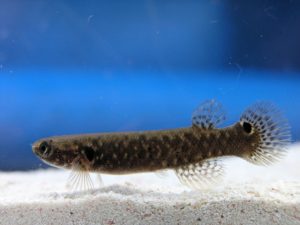
Pollution and chemical imbalances in water could have an adverse effect on animal behavior, particularly in fish that make their home among the mangrove trees along the Florida coast. Dr. Ryan Earley and his students are charting multiple courses to determine what causes changes in how the fish function.
“Our research program has a bunch of different prongs to it,” said Earley, an associate professor in The University of Alabama’s Department of Biological Sciences. “I would say the biggest prong is asking questions about how pollutants infiltrate the environment, especially aquatic ecosystems, and then have damaging effects on the individuals who live there.”
One species of fish in particular caught Earley’s attention. Mangrove rivulus, sometimes referred to as mangrove killifish, live in the waters surrounding their namesake trees, which stretch from the Tampa area to the Florida Keys. They are small fish, and their color ranges between speckled gray and dark brown. What makes them particularly unique, though, is how they reproduce.
“They exist as self-fertilizing hermaphrodites, which basically means they have both boy and girl reproductive parts, make sperm and egg and then can fertilize their own eggs,” Earley said. “This is the only vertebrate that can do it.”

However, that’s not the only way mangrove rivulus can reproduce. Hermaphrodites can change sex into males and mate with other individuals that retain both sexes, although mating between them is rare. Earley and his students are trying to find out why rivulus switch to males if they can self-fertilize from the beginning of life.
While survival could be the underlying reason the rivulus changes sex, Earley is investigating if pollutants, specifically pharmaceutical drugs, also play a role.
“I think at this point in time it’s a safe bet that all of the waters that we interact with are polluted to some degree,” he said. “It can come in the form of, for example, synthetic estrogens for regulating reproductive cycles, and all of these things eventually get into our natural waterways.”
Earley said synthetic estrogens are endocrine disrupting compounds, which can wreak havoc on the human body as they introduce a new source of artificial hormones. As the body discharges these synthetic hormones into water sources, nanogram levels of these chemicals make their way back into the wild, eventually reaching the fish population and altering their physiology.
Earley thinks researchers can also determine how these chemicals potentially alter human behavior and physiology.
“It’s a huge leap to go from a fish to a human, but maybe 10 or 20 years down the road somebody will see the data that we’ve collected and be like, ‘now we can help with these aberrant behaviors that humans are showing and that may be related to exposure to synthetic chemicals,’” he said.
That’s why he urges his students to take what they’re learning at UA, further their academic careers and multiply their knowledge.
“I hope that all of the stuff that we do collectively at some point is used in a way that can either improve ecosystem health, improve our understanding of the complexities of the animals that live in these aquatic systems or even improve human health.”